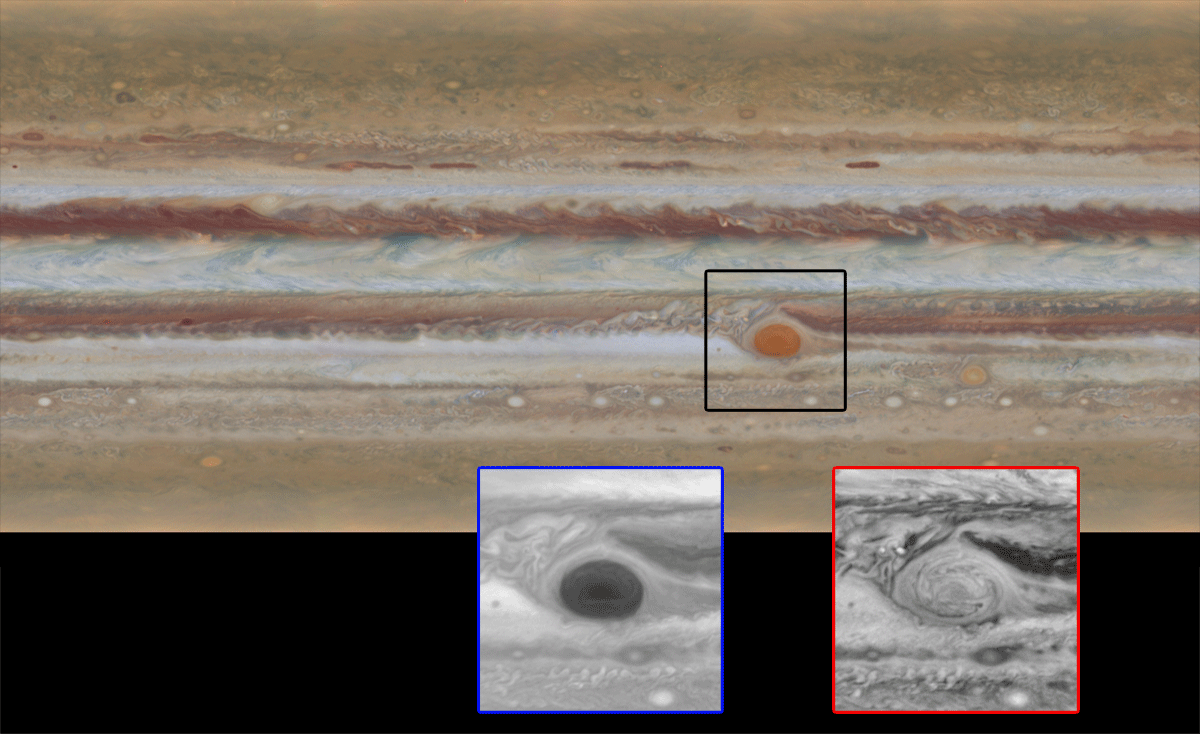Hubble reveals Jupiter's clouds and storms like never before
Meteorologist/Science Writer
Wednesday, October 14, 2015, 12:30 PM - Track Mark Watney's journey across Mars, follow Cassini as it dives past icy Enceladus, and witness incredible new hi-def maps of Jupiter's cloud bands and immense Great Red Spot. It's What's Up In Space!
Follow The Martian's journey across the Red Planet
Have you seen The Martian yet? Were you spellbound by the grand vistas of Mars as we followed Mark Watney's tale of survival?
While the movie and book are fictional, you can now see the very real terrain that serves as the backdrop for the story, thanks to NASA's Mars Trek:

Screenshot of NASA's Mars Trek, showing the waypoints of Mark Watney's journey. Click or tap image to experience this interactive adventure.
Much of this overlapping satellite imagery of Watney's path was taken by the ESA's Mars Express orbiter, and while it starts you off with a simple 2-dimensional map, there is much more available from this interactive viewer.
Have a pair of anaglyph (red/blue) 3D glasses? Start up Mars Trek, click the "3D" option in the bottom left corner and slip on those glasses to see the terrain pop out of the screen.
Want to go on a complete 3D tour of the trek, complete with commentary by NASA's Dr. Jim Green? You can do that too! Make sure you're in 3D view, open the bookmarks tab (top right, third icon down), select and add the The Martian Path. Then use the green Start 3D Tour button to get underway!
Diving past Saturn's icy Enceladus
NASA's Cassini spacecraft is on a final tour of Saturn's various moons, and today - Wednesday, October 14, 2015 - the north pole of Enceladus is in its camera's sights.
During this flyby, visualized in the animation below, Cassini will come to within just 1,839 kilometres from the surface, sweeping past to snap high-resolution imagery of the features there.
According to NASA:
During this flyby, Cassini will image the north polar regions of Enceladus -- something not possible in the first years of the mission, when the moon's north pole was in darkness. Scientists are eager to search for indications of whether the north polar region might have been geophysically active at some time in the past. There are also two plume observations designed to allow scientists to better understand the connection of specific jets to surface hot spots, and to search for variability in the plumes. After this flyby, only two close Enceladus flybys remain before the end of the mission in 2017.
The images taken by Cassini today will be transmitted back to Earth and should be available to view on their website just in time for Friday's Science Pics of the Week!
Hubble's new maps of Jupiter reveal incredible complexity
It doesn't take much to see Jupiter's cloud bands from Earth. Anyone with a decent backyard telescope can pick them out on a clear night. However, short of actually sending an orbiter, the Hubble Space Telescope is just about our best bet for capturing the amazing details in these bands and especially the immense storm churning away there - the Great Red Spot.
The Weather Network's Kim McDonald presents the new globe of Jupiter in the video spot that leads off the article, and NASA has provided beautiful flat maps of the planet, including this animated image that shows off the motion of the clouds and the Great Red Spot.

Inset images provide detailed looks at the Great Red Spot in both blue and red wavelengths, revealing features never before seen. Credits: NASA/ESA/Goddard/UCBerkeley/JPL-Caltech/STScI
According to NASA:
Already, the Jupiter images have revealed a rare wave just north of the planet’s equator and a unique filamentary feature in the core of the Great Red Spot not seen previously.
"Every time we look at Jupiter, we get tantalizing hints that something really exciting is going on," said Amy Simon, a planetary scientist at NASA’s Goddard Space Flight Center in Greenbelt, Maryland. "This time is no exception."
Simon and her colleagues produced two global maps of Jupiter from observations made using Hubble’s high-performance Wide Field Camera 3. The two maps represent nearly back-to-back rotations of the planet, making it possible to determine the speeds of Jupiter’s winds. The findings are described in an Astrophysical Journal paper, available online.
The new images confirm that the Great Red Spot continues to shrink and become more circular, as it has been doing for years. The long axis of this characteristic storm is about 150 miles (240 kilometers) shorter now than it was in 2014. Recently, the storm had been shrinking at a faster-than-usual rate, but the latest change is consistent with the long-term trend.
This new Hubble look at Jupiter is the first in a series for NASA's OPAL program - the Outer Planet Atmospheres Legacy - which will catalogue new global pictures of Jupiter, Saturn, Uranus and Neptune for study and our enjoyment.
“The long-term value of the Outer Planet Atmospheres Legacy program is really exciting," Michael H. Wong, study co-author from the University of California, Berkeley, said in a NASA statement. "The collection of maps that we will build up over time will not only help scientists understand the atmospheres of our giant planets, but also the atmospheres of planets being discovered around other stars, and Earth’s atmosphere and oceans, too."
What's coming up?
October 21/22 - Peak of the annual Orionid meteor shower
Sources: NASA/DLR | NASA JPL | NASA/Hubble



